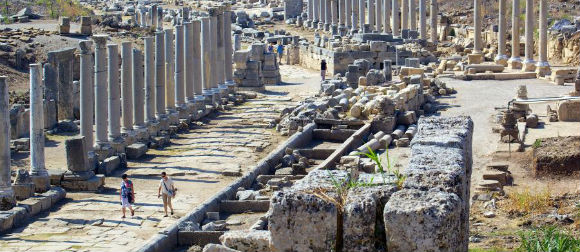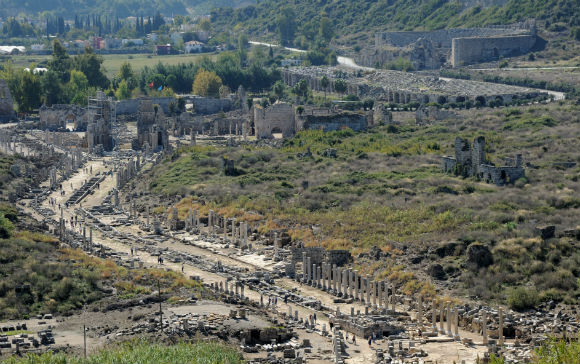The most impressive ruins of the Pamphylian coast are at Perge, at about 15 km east of Antalya. Perge was originally founded by the Hittites around 1500 BC. and was known as Parha. It was a successful trading centre near the Aksu (ancient Kestros or Cestrus) river when Alexander the Great arrived in 333 BC. He was welcomed in by the inhabitants and used Perge as base for his Anatolian campaigns. Alexander was followed by the Seleucids under whom the city prospered and Perge’s most celebrated inhabitant, the mathematician Apollonius from Perge lived and worked. Apollonius was a pupil of Archimedes and wrote a series of eight books on geometry. In 188 BC Perge became part of the Roman Empire during which the city flourished. Most of the surviving buildings date from this period.In 46 AD St. Paul started his journey in Perge (biblical Perga) and preached his first sermon here. Perge gradually declined during the Byzantine period, as the Aksu river silted, but remained inhabited until Selçuk times after which it became abandoned.
A visit to Perge starts by entering the archeological site through the Roman Gate, built during the reign of Septimius Severus (193-211 AD). Proceeding through the gate, to the right is the Agora or market place. This structure of 75 x 75 m dates back from the 2nd century AD. The center courtyard and shops were surrounded by a wide stoa, a covered walkway. The floor of the stoa and shops was made of colored mosaics. The agora was not only the centre of Perge’s trade, but was also a place for meetings as well as a forum for political, social, and philosophical discussions. The next building is the Hellenistic city gate that dates back to the 3rd century BC. This is certainly the most imposing building of the city and was cleverly designed to protect the city with its twin towers and its horseshoe-shaped courtyard at the back. It is thought that the towers had three floors and were crowned by a conical roof. In the year 121 AD, the horseshoe-shaped courtyard was rededesigned as a courtyard of honor. Behind the courtyard stood a triple arch. Around the arch there are about dozen inscriptions connected with Plancia Magna who lived in the 2nd century AD. She was the daughter of the governor, a priestess of Artemis Pergaia (Diana) and a benefactress to the city. Plancia Magna had the arch decorated with the statues of the emperors and their relatives.
After passing through the Hellenistic Gate and courtyard, one enters a broad, marble-paved double-colonnaded street measuring 300 meters in length that extends from the main gate to the acropolis. The street is 20 m wide and is divided in two by a 2 meter wide water channel running down the middle. At the end of the colonnaded street is the Nymphaeum, a triumphal fountain from where a stream flowed down into the water channel. The nymphaeum or nymphaion is an ornamental semicircular structure and dates from the reign of Emperor Hadrian (130-150 AD). A statue of a river god Kestros was located in the center of this huge fountain. Behind the nymphaeum is the acropolis with some remains of the Byzantine period. To the west of the nymphaeum are the remains of a palaestra dating from 50 AD and dedicated to the Emperor Cladius (41-54 AD).
Returning back to the entrance, there are the excavated Roman baths located southwest to the agora. Out of the site proper, is the horsehsoe-shaped stadium, the largest in Asia Minor, measuring 234 m by 34 m. The stadium had a seating capacity of 12,000 people supported by massive barrel-vaulted constructions. Just beyond the site entrance is also the theatre, which is of the Greco-Roman type and could seat 15,000 people. Unfortunately, it is for some time under reconstruction and unfortunately closed to visitors.
Perge,



Visited Perge whilst on a trip to Aspendos. Well worth the visit, loved wandering around the site. Lots to see take your camera and drinks. Like most of these places it can get hot.
Had a guide so we did not miss anything, great to hear about the history of the place.
The bath complex was amazing. Those Romans new how to live. There is still so much at this site to be dug up and restored. I expect many great things will come out of this site as archeologists continue to work the site.
Well mainteined site.
Important to start early in the morning in summer days since it's very warm and not much shade.
We've been to a lot of ruins in Turkey, and these are fabulous. There is a lot to see, but the site is flat and sandy, so it is an easy walk. Many of the building still have high walls intact, which is unusual. The baths are particularly interesting, and the agora is massive with re-erected columns on all four…
Very unusual ancient city due to the existence of both a Greek and Roman gate to the city. Baths are in good condition as are the streets with columns. Plenty of opportunities for photo compositions which isolate on the Greek and Roman architecture of an ancient city. Barren site, so trees and other greenery will not available for shade or…
One of best preserved ancient cities with 2000+ year old history just outside Antalya. It has everything: Stadium, Theatre, Baths, Agora, which is my favourite.
15TL per person for entry. They don't accept other currencies like most of the rest of Turkey, but they do accept credit card – if the phone/card machine is working! This is a must-visit site. It is huge, old and as the title suggests, awe-inspiring. Not much shelter so pick an overcast day to visit or slap on the suncream!…
world-famous ancient Greco-Roman theater of Aspendos, Perge, was one of the most important and beautiful ancient cities along the coast we were told. The apostle St.Paul preached here during his missionary journey and Perge is also known for being the birthplace of the famous mathematician Apollonius. We saw the ruins of the antique theater capacity for an audience of 12,000…
Big place easy to walk around. Not full of tourists and in good conditions that will allow you to imagine how all these stones were in a time buildings and streets.
A very good site with plenty of Roman ruins in a very good state of disrepair if you know what I mean. Entrance was 10TL per adult, kids free. Lots of columns, roman baths, gates, central square that allow you to imagine life as a roman. well worth a visit.